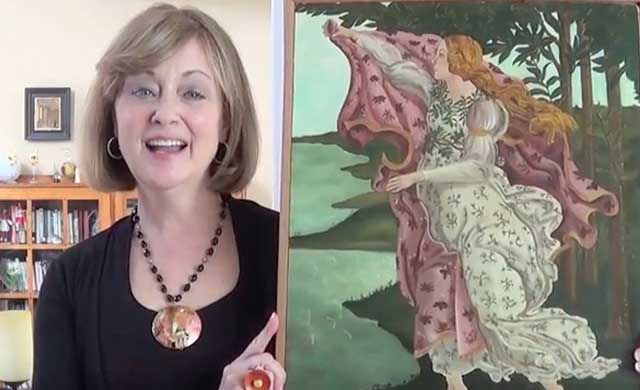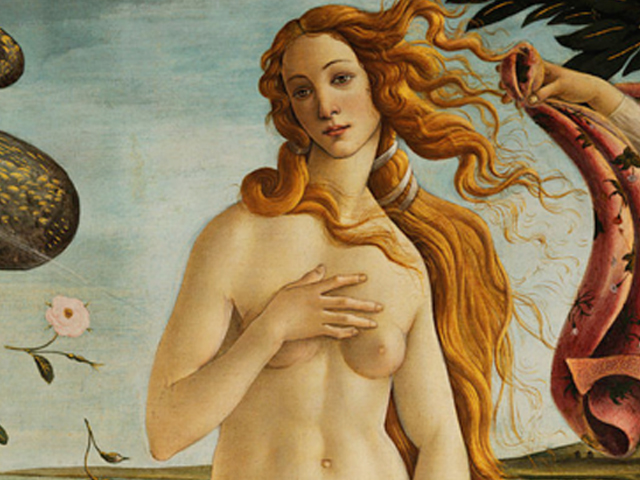
Today I want to talk to you about Botticelli’s Birth of Venus, and the representation of the ultimate ideal of female beauty and where Botticelli derived his inspiration.

This is a small detail of Botticelli’s much larger painting, that I painted when I was a student in Florence. I attended a course in the Oltrarno when I lived there and it was my “homework” to choose a painting from the Uffizi and copy it. I chose Botticelli’s painting because I was struck by the colors, the intricate details, and the graceful figures—like this young girl dressed in a flowing white dress sprinkled with flowers.
Botticelli painted the Birth of Venus
around the year 1482.
Just as Michelangelo’s David is considered the canon of male beauty, Venus in Botticelli’s painting has always been considered the perfect idea of female beauty in art.

It has long been suggested that Botticelli was commissioned to paint the piece by the Medici family – specifically influenced by Lorenzo il Magnifico.

In this painting, Botticelli has depicted Venus as a young woman with flowing tresses of golden hair standing completely naked on a seashell. Keep in mind, for the patrons Botticelli painted the picture for, the nakedness of the Venus wasn’t intended to be a representation or exaltation of pagan rituals. Rather she embodied the concept of Humanitas, a depiction of spiritual beauty that represents purity, simplicity, and nobility of the soul. There is also a parallelism between Venus and the Christian soul which is purified by being baptized by water.
Botticelli’s Venus seems pure and innocent—almost virginal in her modesty. She advances towards us, along the surface of the sea that is rippled by waves, in all her grace and beauty… almost like an ancient statue.

In fact, Botticelli used this ancient statue for reference… a statue that was in the Medici family collection. Botticelli would have had the opportunity to study it in his spare time.

compared to an ancient Greek statue of Aphrodite
In the picture, there are also other characters. Venus is pushed forward and warmed by the breath of Zephyr, who is hugged by a female character that symbolizes the physicality of the act of love. Venus thus is powered by the winds of passion. Perhaps the female figure is the nymph Chloris.

On the shore is a young girl, one of the hours who presides over the changing seasons, especially spring. She waits, ready to cloth the goddess in a beautiful pink robe embroidered with flowers.

The face of Venus seems also to have been inspired by a real woman.
Who was she?
Botticelli was not only inspired by the ancient statue, but it seems that the face of Venus was also inspired by the features of a real woman, Simonetta Vespucci. She was the young woman married to the cousin of Amerigo Vespucci, the famous explorer. It was said that her beauty was unparalleled and she was praised by Florentine artists and poets.

It seems quite perfect that Simonetta was born in the city of Portovenere — Porto di Venere.
Simonetta was truly a fascinating woman and rumors say that Botticelli fell in love with her. But they didn’t have a story. Instead of an affair of the heart, they had an affair of art as Simonetta modeled for Botticelli for many, many paintings.

Purtroppo la donna ha avuto una vita breve ed è morta all’età di ventitré anni.
At Simonetta’s funeral, there was a huge crowd and her coffin was left open so that everyone could admire the beauty that death had not clouded. Simonetta was buried in the church of All Saints, in the Vespucci Chapel frescoed by Ghirlandaio.
In the same church, there is also the tomb of Botticelli who had asked to be buried at her feet. Romantic, right?


Before concluding I want to explain to you how Botticelli earned his nickname “Botticelli” for, in fact, his real name was Alessandro di Mariano di Vanni Filipepi.

“Adoration of the Madonna”
It seems that his older brother, his very
fat older brother was nicknamed “botticella”
the “big barrel.” So by default, his thinner,
little brother was called the
“little barrel” or “botticelli.”
We just took a small leap back into the days of Botticelli,
the Medici, and the early Renaissance
AND an even bigger jump back to classical Greece!
If you’d like to watch a Youtube Video featuring this post in Italian and English click on the link below.







Beautiful and romantic! Thank You for taking the time to put this together. I am dating a woman who resembles (her face) the gorgeous Simonetti – the resemblance is quite striking, though I never noticed it until a few days ago.
I am on the web this afternoon searching for the origin of the Venus (half shell) image used by Simone Mosca in the wilderness garden at Bomarzo. I am assembling a program for my painting show of the Bomarzo garden and the life of Pier Francisco Orsini. And, I discovered your site and video. I have subscribed and would be thrilled if you knew if Botticilli originated the half shell for the “Birth of Venus”. Janet